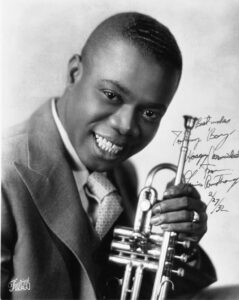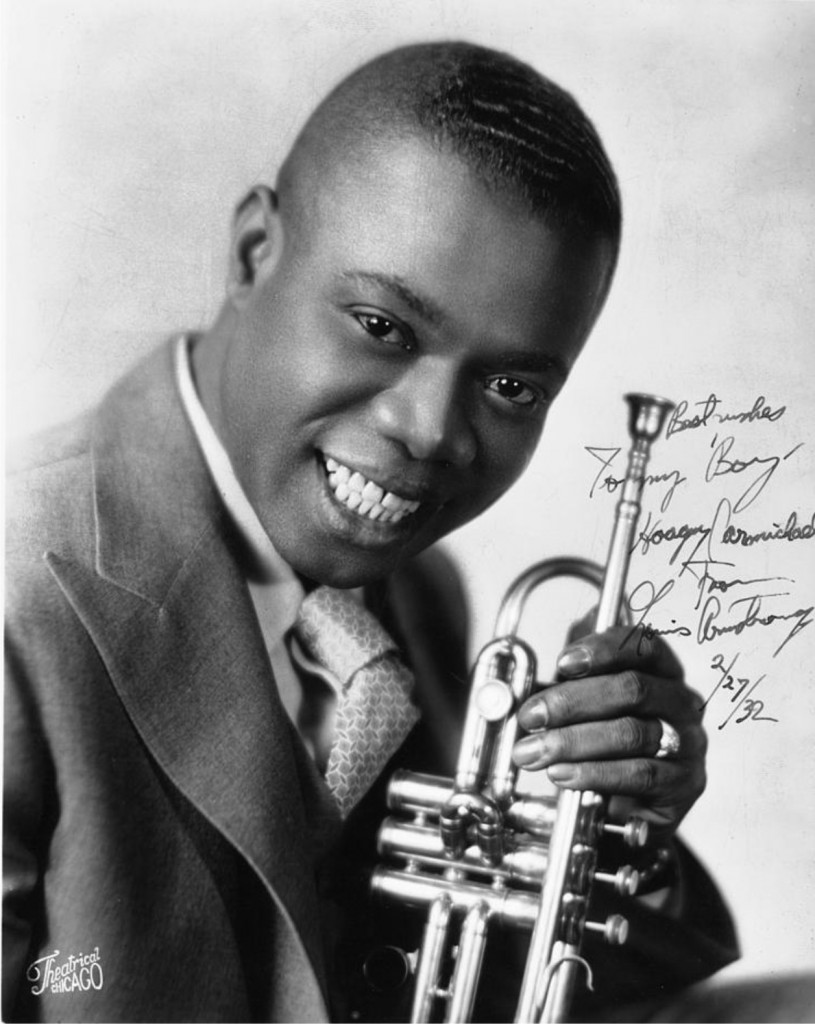
Whether you’re a beginner, intermediate, or advanced jazz pianist, Louis Armstrong can teach you a lot about how to play jazz piano better.
I myself didn’t always fully appreciate this, though. I started out, like many beginners, by listening to and emulating the great bebop and post-bebop jazzers like Charlie Parker, Oscar Peterson, and Chick Corea. I did enjoy playing stride piano too, but I never focused much on individual artists like Armstrong. Big mistake! I’ve gradually come to realize that Louis Armstrong’s playing has truly set the stage for all of the jazz that followed him, and that his musical example is a treasure chest of inspiration and yes, instruction, for us as contemporary jazz pianists.
Here are 5 ways that you as a jazz pianist can learn from Louis Armstrong:
1. You’ll develop a better sense of “swing!”
Armstrong played with an exceptionally a strong sense of “swing,” which is central to jazz. The bebop drummer Max Roach used to talk about this a lot. I attended some workshops back in the 1980s with Max and he spoke about swing rhythm in a way I had never thought about before. He said that Louis Armstrong was the master of swinging quarter notes, Lester Young was the master of swinging 8th notes, and Charlie Parker was the master of swinging 16th notes. Max didn’t mean that Armstrong only played quarter notes, of course. He was referring to how Armstrong leaned into the quarter notes he played, and how they had a certain buoyancy that related to the underlying swing beat. Armstrong also played 8ths and 16th, of course, but the quarter note pulse was the basis of his sense of swing, as Max Roach understood it. When the man who’s perhaps the greatest jazz drummer in history points you toward Louis Armstrong’s sense of swing, he’s giving you a big clue as to you yourself can develop a better swing feel swing!
As you’re listening to Armstrong’s playing, try to absorb and internalize his rhythmic feel. And then let it come out in your own playing, even if you’re playing a more modern style of jazz. Armstrong is the root of jazz’s family tree, and his influence can be felt in everything that has come since.
You can hear Armstrong’s strong quarter-note pulse in measures 1 and 3 of “Potato Head Blues.” You can also hear it throughout his improvised solo later on in the recording. This is one of his greatest solos; enjoy!
2. Armstrong played clear phrases, that always had a beginning, a middle, and an ending.
Many jazz pianists, even good ones, aren’t very clear in their phrasing. And it’s not something that we can always recognize in our own playing. I remember once when I was improvising on “Tune Up” for my jazz piano teacher, Billy Taylor. I thought I had played pretty well, but when I was finished, Billy said, “Well you know, Ron, you start each phrase well, but then you just trail off at the end. Make sure you end each phrase clearly.
His comment surprised me, and it took me about a week of careful listening until I understood what he was trying to tell me and I could hear it in my playing.
Listen to how clear Armstrong’s phrases are. Every single one. It’s relatively easy to hear this in Louis’ playing, but one you can hear it, you’ll notice how clearly most of the legendary jazz musicians played, even those who played very differently than Armstrong himself did. Teddy Wilson, Charlie Parker, Sonny Rollins, and even “out” players like Ornette Coleman played clear phrases.
Listen to Armstrong’s clear phrasing on “Gut Bucket Blues” and then have a good listen to your own playing. Do your improvised phrases have a clear beginning, middle, and ending? You might be surprised at how much your playing will improve when you play attention to your phrasing for awhile.
Here’s “Gut Bucket Blues.” The trumpet solo starts at 2:00.
3. Mix up your accompaniment textures
Listen to what the rhythm section plays behind Armstrong’s trumpet solo on the classic “Struttin’ With Some Barbeque.” (The solo begins at 1:34.) They just play on beats 2 and 4! Even though there are only 5 band members, the groups achieves a remarkable amount of variety though the use of textures such as this.
Think about this for a minute. How many times have we all played for an entire evening only to realize that all the music sounded the same? But it doesn’t have to be this way. We can take a cue from Armstrong and his bandmates and make our own performances more lively and interesting by varying the accompaniment textures we play.
For starters, you might pre-arrange that your rhythm section will play on beats 2 and 4 behind a specific soloist, just like Armstrong’s Hot Five did. Or you could write out specific rhythmic “hits,” like a big band arranger would. (Duke Ellington did this behind Max Roach on the song “A Little Max (Parfait)” from the album Money Jungle.
Or you could simply vary the piano textures you use behind each soloist. This might mean playing in a higher register for one soloist and a lower register for another. Or more open voicings behind the sax solo and closed voicings while the trumpet player solos. Or, if there’s an additional chordal instrument in your group, such as guitar, you can comp behind one soloist and the guitarist can accompany the second. Mix it up and try new things. Both you and your audience will notice the difference.
4. Armstrong had such a strong musical personality that his singing is identical to his trumpet playing.
The earlier jazz greats tended to compliment a player by remarking that they “really have something to say.” I used to her this a lot from my teacher Billy Taylor and the musicians he played with. It’s not just about sounding “good.” They considered it very important to hear and feel the music from deep inside yourself and express that through your instrument.
The incredible thing about this is that when you really “have something to say,” it comes out naturally, whether you’re singing, playing your main instrument, or whatever. Some of the great jazz musicians even speak wit the same tone as they play. (Have you ever noticed how Miles Davis’ trumpet tone changed when his voice got raspy?)
Louis Armstrong illustrates this very well, and his song “Heebie Jeebies” is a good place to start. (It also has immense historical value as the first recording to feature “scat singing!”) Check out how he sings the melody and scats. The note choices and phrasing are almost identical to how he’d play it on trumpet.
Heebie Jeebies
5. Your playing will become more joyous.
No explanation necessary for this one. Love life, and let it come out in your playing. No one did this better than Satchmo.
When You’re Smiling
As we’ve seen here, we jazz pianists can learn a lot from Louis Armstrong. If you study his music seriously as I’ve outlined here, you’ll develop a deep, buoyant sense of swing and your improvised phrases will become clearer and more logical. You can also take inspiration from Armstrong’s Hot Five and Hot Seven recordings to spice up and vary your accompaniment textures, both on piano and with your whole rhythm section. Armstrong can also serve as a role model to help you develop your musical individuality to the fullest degree possible, and to express it through your piano playing and possibly while singing (even just while practicing!) Finally, We can take a cue from Louis to let a real sense of joy shine through as we perform our music.
Remember, you don’t have to play like Louis Armstrong to be inspired by him. Listen to the recordings above, absorb the lessons he can teach you, and then let them come out in all the music you play. Good luck and have fun!
Take your left hand playing to a new level with my free ebook: Left Hand Techniques for Jazz Piano
You’ll also get my weekly jazz newsletter with practice tips and inspiration

